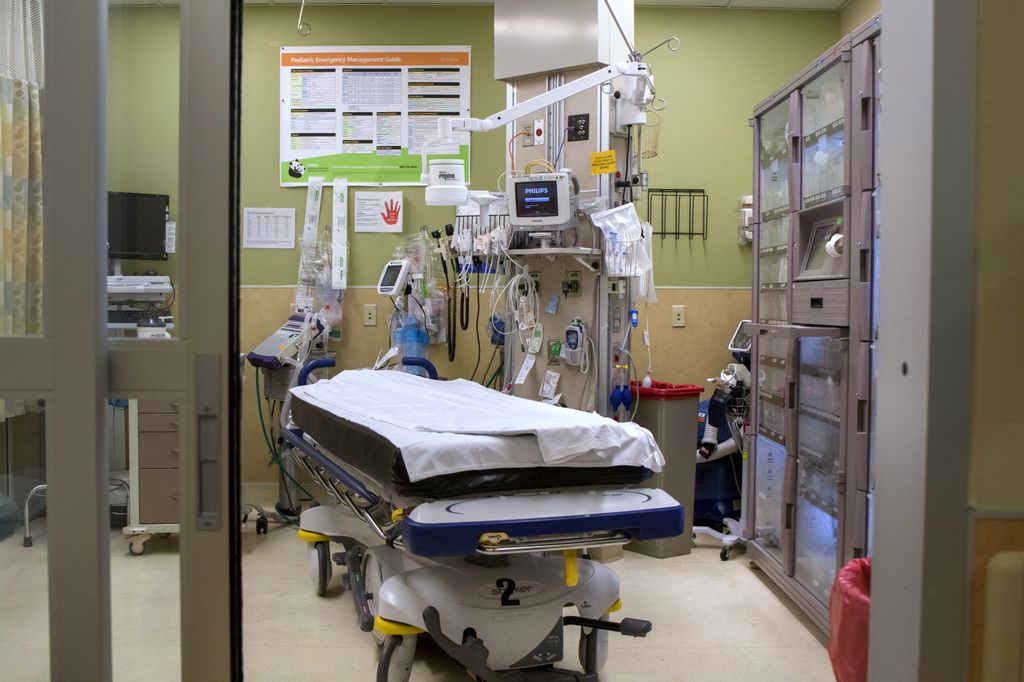
Emergency rooms, like the one at Oregon Health & Science University, treat Oregonians with opioid overdoses. (Christine Torres Hicks/OHSU)
The federal government’s push to make Medicaid funding more flexible for drug addiction treatment in the last nine years has not stemmed the tide of nonfatal opioid overdoses, an Oregon Health & Science University study found.
The study, published this month in Health Affairs, comes as Oregon is fighting an epidemic of opioid overdoses driven by illicit fentanyl use. On a national level, the study scrutinizes a 2015 change made to Medicaid, which provides health care to nearly 80 million low-income people nationwide. That federal change allowed states to seek a waiver so large institutions can provide Medicaid-funded addiction treatment.
That change, made in response to rising overdoses, marked a shift in decades of federal policy dating back to the 1960s that prohibited funding addiction treatment in residential facilities with more than 16 beds. But the change that opened up a flow of money to larger institutions has not been enough to combat overdoses, the study found.
“The waivers have been important to update Medicaid’s program to treat opioid use disorder, however they alone do not appear to have meaningfully improved the situation in terms of uptake of medication to treat opioid use disorders or in reducing overdoses,” said lead author Stephan Lindner, an associate professor in the OHSU Center for Health Systems Effectiveness and a faculty member of the OHSU-Portland State University School of Public Health.
The study looked at 17 states that participated in the waivers that allowed the larger institutions to treat addiction from 2017 to 2019 and compared their outcomes to 18 states that did not. In all, the study included about 1.7 million people on Medicaid who’d been diagnosed with an opioid addiction, and about two-thirds of them lived in states with waivers.
Those 17 states with the waivers are: Alaska, Delaware, Indiana, Kansas, Kentucky, Louisiana, Michigan, New Hampshire, Nebraska, New Jersey, New Mexico, Pennsylvania, Ohio, Virginia, Washington, West Virginia and Wisconsin.
Oregon did not participate in that Medicaid initiative in the period studied, though in 2021, Oregon obtained a waiver that allows larger institutions to treat substance use disorders through Medicaid. Thirty-four states, including Oregon, participate in the waiver program.
The state’s Oregon Health Plan, the Medicaid-funded program that provides health care, dental care and behavioral health care services to low-income people, serves 1.4 million people, or about one in three Oregonians.
In Oregon, about 1,400 people died of opioid overdoses in 2023, up from 280 in 2019, according to Oregon Health Authority data. Thousands more needed emergency treatment. In 2022, Oregonians made nearly 3,300 visits to hospital emergency rooms for opioid consumption.
Study results
The federal government started that waiver to increase access to methadone and other medication treatments for opioid addiction that are used to prevent withdrawal symptoms for people after they stop using the drugs.
The researchers looked at outcomes in states with the waiver and found only modest increases in medication for people enrolled in Medicaid.
The use of methadone, considered the gold standard in treating opioid addiction, increased by 2.3 percentage points with coverage changes, with about 7,300 more people every three months taking the medication in states with the waiver.
And providers increased the use of all opioid treatment medications for people on Medicaid with a severe addiction by 3.7 percentage points – a jump of 4,000 more people in an average three-month period in states with the waiver. They included people on Medicaid with a severe addiction who stayed in a hospital or residential facility.
But thousands in the states studied did not access medication treatment. Even with the overall increase in medication, less than half of the population diagnosed with an opioid use disorder – 48% – did not receive medication in a given three-month period. For a typical three-month period, that would mean about 164,000 people did not receive medication.
The study said the waiver programs did not bring about “significant improvements in medication treatment or reductions” in nonfatal opioid overdoses.
“However, they may have moderately improved medication treatment for those with severe opioid use disorder,” the study said.
In some of the states that started the waiver earlier, there were better outcomes, like Lousiania and Virginia. The study suggested that those states were prepared and motivated to make substantial changes to their Medicaid programs.
“More substantial efforts at the federal level are required for a stronger response to the (opioid use disorder) crisis in Medicaid,” the study said.
The study’s author, Lindner, said the waiver alone is not the answer.
“There’s a lot more states need to do in order to really effectively combat and address the opioid crisis,” Lindner said in an interview.
Those efforts apply to Oregon as well as others. They include improving access to methadone, which can only be administered through specialized clinics in approved opiate treatment programs. That makes access difficult, such as in rural areas, even though methadone is approved through Oregon’s Medicaid program and has been since the 1990s.
In 2021, OHSU researchers recommended making access to methadone easier, such as through primary clinics, as overdose deaths surged during the COVID-19 pandemic.
Federal regulations that limit methadone’s use put the U.S. behind other nations. A recent study by OHSU physician Dr. Honora Englander found that 87% of people with opioid use disorder in France received access to methadone compared with less than 20% in the United States.
Other steps include more distribution of naloxone, which can reverse overdoses and prevent deaths. Initiatives across the state have boosted naloxone use. OHSU has made efforts to distribute naloxone, and a state-funded initiative called Save Lives Oregon has distributed 391,000 naloxone doses across the state, with a reported 7,500 overdose reversals.
GET THE MORNING HEADLINES.

